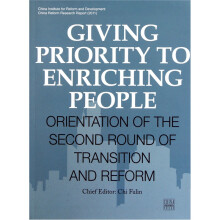Preface
Introduction: China is Confronted with "Middle Income Trap"
Chapter I: Entering the Era of Public Goods Shortage
Section I From Personal Goods Shortage to Public Goods Shortage
Ⅰ. Personal goods and public goods: definition of concept
Ⅱ. Stage of survival and personal goods shortage
Ⅲ. Development-oriented stage and public goods shortage
Section II All-round Rapid Growth of Development-oriented Demand
I. The Level Of Development-Oriented Demand Is Higher
II. All-round rapid growth of development-oriented demand
Section III Changes in Demand Structure will Surely Initiate Changes to Economic Structure
Ⅰ. It will initiate profound changes to investment, export and consumption structures
Ⅱ. It will initiate profound changes to industrial structures
Ⅲ, It will initiate profound changes to the structure of material capital and human capital
Section IV From Personal Goods Shortage to Public Goods
Shortage--Historical Starting Point of the Second Round of
Transition and Reform
Ⅰ. Public goods shortage reflects new stage-associated changes in social contradictions
Ⅱ. Development-oriented demand has become the endogenous motive force for economic and social development
Ⅲ. The second round of transition and reform with emphasis on self-developmentof people is at a new historical starting point
Chapter II: From Giving Priority to Enriching State to Giving Priority to Enriching People
Section I Historical Transition from Giving Priority to Enriching State
to Giving Priority to Enriching People
Ⅰ. Personal goods shortage and historical role of giving priority to enriching state
Ⅱ. Historical defect of giving priority to enriching state when public goods are insufficient
Section II Giving Priority to Enriching People to Realize Fair and Sustainable Development
Ⅰ. Giving priority to enriching people is conducive to expanding consumption
Ⅱ. Giving priority to enriching people is conducive to narrowing income distribution gap
Ⅲ. Giving priority to enriching people is conducive to promoting social equality
Section III Strategic Choice of Giving Priority to Enriching People
Ⅰ. From development of materials to human development
Ⅱ. From economic aggregate-oriented development to national income-oriented development
Ⅲ. Becoming a big consumer power
Chapter III: "The Twelfth Five-year Plan" at the Historical Turning Period
Section I Transition from an Investment-led Pattern to
Consumption-led One
Ⅰ. It is difficult to continue the investment and export-led pattern
Ⅱ. China has the initial basic conditions to build a big consumer power in "the Twelfth Five-year Plan" period
Ⅲ. Initially shaping the consumption-led basic trend
Section II Transition from Industrialization Orientation to Urbanization Orientation
Ⅰ. Transition from Industrialization Orientation to Urbanization Orientation
Ⅱ. Selection of road to push forward urbanization
Ⅲ. Initially shape the new urbanization-guided pattern during "the Twelfth Five-year Plan"
Section III Transition from Middle and High Carbon Economy to Low-Carbon Economy
Ⅰ. Low carbon economy is a new development pattern
Ⅱ. Economic growth during "the Twelfth Five-year Plan" period should be linked with total energy consumption
Ⅲ. China has basic conditions to develop low-carbon economy during "the Twelfth Five-year Plan" period
Ⅳ. Developing low-carbon economy should emphasize on institutional innovation
Section IV Transition from Public Goods Shortage to Equality of Basic Public Services in Urban and Rural Areas
Ⅰ. Significant effect of equalizing basic public services on transition of development pattern
Ⅱ. Initially shape the pattern of equalized urban and rural basic public services
Ⅲ. Make new breakthroughs in achieving equality of basic public services during "the Twelfth Five-year Plan" period
Ⅳ. Build and perfect the basic public service system benefiting . billion people
Chapter IV: The Second Round of Transition and Reform with Priority to Enriching People
Section I The Second round of transition with Priority to Enriching People
Ⅰ. The first transition: change relations of production and increase economic aggregate
Ⅱ. The second round of transition: change the economic structure and build a big consumer power
Ⅲ. March towards fair and sustainable scientific development
Section II The Second Round of Transition Depends on the Second Round of Reform
Ⅰ Institutional dividends of the first reform are gradually decreasing
Ⅱ. There are great spaces of institutional dividends in the second round of reform
Ⅲ. The second round of transition depends on the second round of reform
Section III Determine the Orientation of the Second Round of Reform with Priority to Enriching People
Ⅰ. Economic system reform with marketization as the main line
Ⅱ. Social system reform with equality of basic public services as the main line
Ⅲ. Reform of administrative system with government transition as the main line
Section IV "the Twelfth Five-year Plan": Seek New Breakthroughs in the Second Round of Reform
Ⅰ. Reform of income distribution system needs substantial breakthroughs
Ⅱ. Let "migrant rural workers" be history
Ⅲ. Optimize allocation of state-owned assets with emphasis on public benefit
Ⅳ. Promote structural reform with emphasis on fiscal and tax system
Chapter V: Government Transition Centering on Public Services
Section I The Second Round of Reform Challenges Government Transition
Ⅰ. A development-oriented government can hardly achieve "enriching people first"
Ⅱ. It is difficult to sustain the government-led economic growth pattern
Section II Determine Government Transition Centering on Public Services
Ⅰ. Strengthen the function of government in economic public services
Ⅱ. Strengthen the function of government in social public services
Ⅲ. Strengthen the function-of government in institutional public services
Section III Strengthen the Role of Public Interest Representatives
Ⅰ. Government development concept focusing on public services
Ⅱ. Change the government tendency for own interests
Ⅲ. Go towards public governance
Concluding Remarks: Choices for the Second Round of Transition and Reform
Ⅰ. The second round of transition and reform is in a critical period for historical choice
Ⅱ. Strengthen the top level design for the second round of transition and reform
Ⅲ. Reach a basic common view on the second round of transition and reform as early as possible

 缺书网
缺书网 扫码进群
扫码进群




